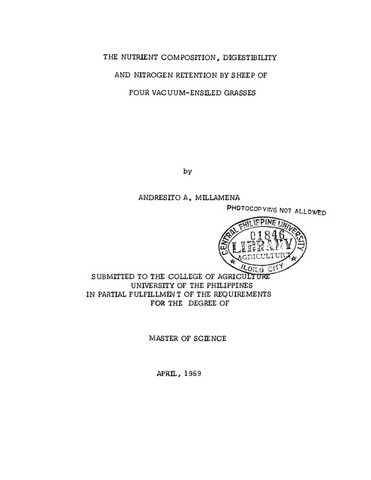The nutrient composition, digestibility and nitrogen retention by sheep of four vacuum-ensiled grasses

Page views
642Petsa
1969May-akda
Tagapayo ng Tesis
Tagapangulo ng Panel ng Depensa
Magbahagi
Metadata
Ipakita ang buong tala ng item
Abstract
The chemical composition of forage or any other feedstuff is a very useful but insufficient information on which to judge its nutritive value for a particular class of livestock. To get a better index, it is necessary to determine the digestibility of the dry matter and the individual organic nutrients, i.e. , protein, fat and carbohydrates. Furthermore, to test the feed's usefulness as a source of protein, it is necessary to determine the availability to and retention by the animal body of its protein component. Thus, there is a need for a nitrogen balance determination in addition to the usual digestion trial.
The data secured in digestion trials provide the general basis for our knowledge concerning the amounts of digestible nutrients furnished by different feeding stuffs. They are highly important to the science of livestock feeding (Morrison, 1956).
The nutrient composition and digestibility of forages may be influenced by a number of factors, among which are as follows: a) species of forage, b) stage of maturity, c) nutrient status of the soil, d) climate or season, and e) processing and conservation methods. The actual feeding value is further affected by the species or class of livestock being fed.
This study was conducted from August 1967 to February 1969 in the Department of Animal Husbandry and Dairy Training and Research Institute, College, Laguna, to determine: 1) the chemical composition of four vacuum-ensiled grass species harvested at 40 to 45 days of age and preserved for about 2 to 3 months; 2) the dry matter intake, digestibility and nitrogen retention by sheep of the four silages; and 3) the pH value, organic acids, total titratable acids and "total" anaerobic bacterial plate count of the four silages. These grasses were grown under the same conditions and harvested at the same age. Sheep were used as experimental animals representing the ruminant group for reasons of convenience and of the limitation of the amount of each grass silage available. The study was also an attempt to determine the workability of the vacuum-ensiling technique.
Paglalarawan
Introduction
Mungkahing Sipi
Millamena, A. A. (1969). The nutrient composition, digestibility and nitrogen retention by sheep of four vacuum-ensiled grasses (Unpublished Master’s thesis). University of the Philippines at Los Baños, Laguna.
Uri
ThesisMga Paksa
Kagawaran
College of AgricultureDegree
Master of Science in Animal Husbandry (Animal Nutrition)Lokasyon ng Istante
GSL Theses 630.72 M61m
Pisikal na paglalarawan
75 leaves
Collections
- Theses [10]

